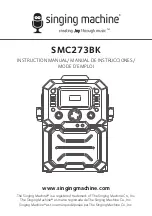
ESAB FABRICATOR 252i
Manual 0-5423 4-1 BASIC WELDING
SECTION 4:
BASIC WELDING GUIDE
4.01 MIG (GMAW/FCAW) Basic Welding
Technique
Two different welding processes are covered in this section
(GMAW and FCAW), with the intention of providing the very basic
concepts in using the MIG mode of welding, where a MIG Gun
is hand held, and the electrode (welding wire) is fed into a weld
puddle, and the arc is shielded by an inert welding grade shield-
ing gas or inert welding grade shielding gas mixture.
GAS METAL ARC WELDING (GMAW): This process, also known as
MIG welding, CO
2
welding, Micro Wire Welding, short arc welding,
dip transfer welding, wire welding etc., is an electric arc welding
process which fuses together the parts to be welded by heat-
ing them with an arc between a solid continuous, consumable
electrode and the work. Shielding is obtained from an externally
supplied welding grade shielding gas or welding grade shielding
gas mixture. The process is normally applied semi automatically;
however the process may be operated automatically and can
be machine operated. The process can be used to weld thin and
fairly thick steels, and some non-ferrous metals in all positions.
Art # A-8991_AB
Shielding Gas
Molten Weld Metal
Solidified
Weld Metal
Nozzle
Electrode
Arc
Base Metal
GMAW Process
Figure 4-1
FLUX CORED ARC WELDING (FCAW): This is an electric arc weld-
ing process which fuses together the parts to be welded by heat-
ing them with an arc between a continuous flux filled electrode
wire and the work. Shielding is obtained through decomposition
of the flux within the tubular wire. Additional shielding may or
may not be obtained from an externally supplied gas or gas
mixture. The process is normally applied semi automatically;
however the process may be applied automatically or by ma-
chine. It is commonly used to weld large diameter electrodes in
the flat and horizontal position and small electrode diameters in
all positions. The process is used to a lesser degree for welding
stainless steel and for overlay work.
Art # A-08992_AB
Molten
Slag
Nozzle
(Optional)
FCAW Process
Flux Cored
Electrode
Arc
Shielding Gas
(Optional)
Slag
Molten Metal
Base Metal
Solidified
Weld Metal
Figure 4-2
Position of MIG Gun
The angle of MIG Gun to the weld has an effect on the width of
the weld.
Push
Vertical
Drag/Pull
Art # A-07185_AB
Figure 4-3
The MIG Gun should be held at an angle to the weld joint. (See
Secondary Adjustment Variables below)
Hold the MIG Gun so that the welding seam is viewed at all times.
Always wear the welding helmet with proper filter lenses and use
the proper safety equipment.
!
CAUTION
Do NOT pull the MIG Gun back when the arc
is established. This will create excessive
wire extension (stick-out) and make a very
poor weld.
The electrode wire is not energized until the MIG Gun trigger
switch is depressed. The wire may therefore be placed on the
seam or joint prior to lowering the helmet.
Butt & Horizontal Welds
Direction of
Travel
5° to 15°
Longitudinal
Angle
90°
Transverse
Angle
Art # A-08993
Figure 4-4
Horizontal Fillet Weld
Direction of
Travel
5° to 15°
Longitudinal Angle
30° to 60°
Transverse Angle
Art # A-08994
Figure 4-5
















































